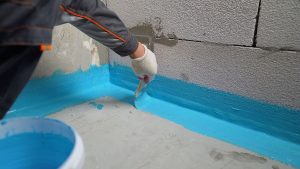Persistent moisture in a concrete slab can blister coatings, buckle flooring, corrode rebar, and invite mold. The right concrete moisture control strategy starts with testing (ASTM F2170 in-situ RH and, where relevant, ASTM F1869 MVER) and then selecting a system that matches the readings and the final floor.
Below is a clear, field-tested guide to the main classes of sealers and membranes used above the slab, plus when they work, and when they don’t.
Two-Component Epoxy Moisture-Vapor Barriers (MVBs)
These are high-build, 100% solid epoxies designed specifically to reduce moisture vapor transmission to levels acceptable for coatings or floor coverings. They’re evaluated against ASTM F3010, which covers two-component, resin-based, membrane-forming mitigation systems (including substrate prep, application, and a strict permeance ceiling). You’ll see compliant products marketed as “moisture vapor barrier epoxies,” often rated for high MVERs (e.g., up to 20 lb/24 hr/1000 ft²) when installed at the specified thickness and profile.
Where they shine: high RH/MVER slabs under resilient flooring, epoxy/urethane coatings, or decorative systems that demand reliable moisture control before you build the floor back. Many industry resources and manufacturers treat F3010-type epoxies as the gold standard for topical mitigation on concrete.
Single-Component Moisture Mitigation Membranes
Historically, ASTM F3010 covered two-component systems only. In September 2024, ASTM approved a new standard (F3513) that addresses single-component, fluid-applied moisture mitigation membranes, broadening the options for projects that benefit from simpler packaging and application. If you’re considering a 1K product, verify it complies with ASTM F3513 and review the manufacturer’s allowable RH/MVER limits.
Penetrating Water-Repellent Sealers (Silane, Siloxane, Siliconate)
Silane and siloxane sealers chemically bond within the pore structure to repel liquid water and chlorides while maintaining vapor permeability. They’re excellent for exterior concrete, parking decks, and freeze-thaw exposure, but they are not vapor-tight mitigation systems for interior flooring. Use them to keep rain and de-icing salts out, not to trap moisture vapor in the slab.
Translation: great hydrophobic “raincoats,” not replacements for F3010/F3513 membranes when a coating or floor covering needs true moisture control.
Densifiers/Hardener Sealers (Sodium/Potassium/Lithium Silicate)
Densifiers react with free lime to form additional C-S-H, hardening the paste and reducing dusting. Some marketing suggests they reduce vapor transmission, but densifiers are not recognized as replacements for topical moisture mitigation systems when RH/MVER is high. Industry guidance repeatedly warns against conflating densification with moisture control for flooring; if testing shows elevated readings, use a tested mitigation membrane.
Acrylic/Urethane Film-Forming Sealers (Thin-Film)
Acrylics and thin urethanes enhance appearance and provide limited stain resistance, but they are not designed to block significant vapor drive. ICRI literature groups them with “fluid-applied sealers” suitable only for closed-slab conditions (effective under-slab vapor retarder, normal RH), often with low warranty limits (e.g., ≤ 8 lb MVER). In open slabs or elevated RH, they risk whitening, blistering, or debonding.
Test First, Then Specify
Moisture is dynamic and influenced by temperature, dew point, and building conditions. That’s why modern practice favors in-situ RH (ASTM F2170) to predict long-term behavior; many flooring manufacturers prefer or require it for warranties. Surface emission (ASTM F1869) can still help in specific scenarios, but don’t rely on one test alone to make high-stakes decisions.
Two quick reminders (only bullets here):
- Waterproofing ≠ moisture mitigation. Waterproofing keeps liquid water out; mitigation membranes address water vapor through the slab. They’re not interchangeable.
- Under-slab vapor retarders matter. If you’re building new, specify a high-quality vapor retarder meeting ASTM E1745 directly beneath the slab per ACI 302.2R. It’s the best long-term defense before you ever need topical mitigation.
Choosing the Right Path for Concrete Moisture Control
If RH/MVER is elevated and you plan to install coatings or resilient flooring, specify either a two-component F3010 epoxy MVB or a single-component membrane that meets F3513. Both classes are engineered and tested to reduce permeance below strict thresholds when installed correctly over a properly profiled substrate (ICRI CSP per manufacturer).
If readings are within limits and the slab is protected below by a vapor retarder, thin-film acrylic/urethane can be used for appearance and light duty, but recognize their moisture tolerance is limited. For exterior horizontal concrete, salt splash zones, and freeze-thaw, silane/siloxane is often the better, breathable choice to keep liquid water and chlorides out without trapping vapor.
If the goal is hardening and polishability rather than moisture blocking, densifiers fit perfectly, but don’t treat them as a vapor barrier solution for moisture-sensitive flooring. When in doubt, test and follow the mitigation standard that applies to your chosen product family.
Application Keys That Make or Break Results
Proper surface preparation governs adhesion and permeance performance. Follow ICRI surface prep guidance (select the correct Concrete Surface Profile, confirm cleanliness, and repair cracks/joints). Then install at the specified film thickness; many F3010/F3513 membranes only meet permeance targets at or above a minimum mil build. Lastly, control temperature/humidity to avoid condensation at the interface—a frequent cause of failures mistaken for “product problems.”
Common pitfalls (second and final bullet list):
- Skipping RH testing because the slab “looks dry.” (Visual dryness ≠ safe RH.)
- Treating densifiers or water repellents as moisture barriers for resilient flooring. (They aren’t.)
Bottom Line
For true concrete moisture control, match the solution to verified test data. Use ASTM-compliant topical membranes (F3010 two-component epoxies or F3513 single-component membranes) when RH/MVER is high and a coating or floor covering is planned. Reserve silane/siloxane for breathable, liquid-water repellency on exterior or above-grade concrete; use densifiers for hardening and polishing, not vapor blocking; and deploy thin-film acrylics/urethanes only when moisture risk is already controlled. Start with testing, apply with proper surface prep, and you’ll avoid costly callbacks.
Need a clear plan for your slab? The team at Custom Concrete Prep & Polish will test, interpret the results, and install a warrantable concrete moisture barrier or sealer system tailored to your site conditions. Request your quote today.



